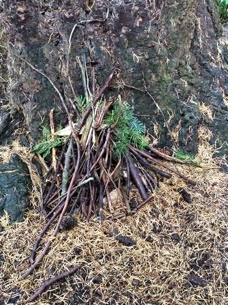It takes just one
person looking or handling just one object for memories to rush back to them
and if you are lucky enough to be in a group when handling that object, you can
share those memories. This concept is not something new, there are many
reminiscence groups associated with museums across the country that hold social
gatherings with this practice in mind. Earlier this week I was fortunate enough
to hear a memory from an elderly English soldier at a stroke club who was not
there to look and handle objects from previous wars he took part in, but masks
from around the world. The gathering was not a reminiscence session and the
objects came from parts of the world that use masks in very different ways than
we associate in the west. This man’s story left me wondering, do we need to
handle objects from our own personal, social or cultural history to spark
reminiscence?
To begin to tackle
this question I will elaborate further on the session, the man’s story, and my
views on the topic.
It was myself and
one of the outreach officers who went out on Tuesday to a stroke club with
masks from the Pitt Rivers handling collection. The day was intended to be a
social gathering of people who have had a stroke and we were there to show them
something different and maybe get them talking about something new.
The session was
going well. There were people there with various degrees of mobility and speech
because of their strokes; some people knew a lot about the Pitt Rivers collection
and some learned new things with every mask; some actively participated and
other just listened and watched. One of the group members was content listening
and looking for almost all of the session. That quickly changed with our last
mask depicting a woman with filed teeth and scarification on her cheeks and
forehead from Africa. This object inspired the man to speak and eventually the
whole room was quiet to hear his story.
That mask had him
share a memory of his from the 1950s when he was in Guinea searching for
Japanese soldiers who had not yet given up on the war. During that time he came
across shrunken heads outside a tribe’s settlement and later found out that
those were the heads from another tribe they fought against. The heads were the
captured losers of the fight and were displayed almost like trophies and also
as a warning to others. He described what a shock it was because not many
westerners knew about this practice during the 50s.
I cannot say for
certain what exactly caused that man to remember his time in Guinea and share
his story and as he had limited hearing and speech difficulties it was not
appropriate to ask him to elaborate further. However, that memory arose when I
was speaking to the group about the body modifications and they all made faces
or sounds of shock. The modifications depicted on the mask were the identifying
features of an ideal woman in the culture it originated. These kinds of
modifications are not widely practiced in western cultural and therefore can be
shocking when learnt about for the first time. Just as it was shocking for the
man to see shrunken heads for the first time, even though the tribe that
displayed these heads outside their settlement were identifying with them as a
symbol of their strong warriors and victories.
To us these seem
like extreme measures to present the ideas and ideals of a culture. However, it
is not too far off from ways we express ourselves in modern western culture.
Ideal women today are on the covers of magazines and we alter those images to
have unobtainable thin waists and over developed chests. The faces so
airbrushed that they show no true features. And as for heads being displayed on
a settlements boundary lines, it wasn’t too far back in British history when we
beheaded losers of battles and placed their heads on the spikes of the gate
into the heart of the city of London.
What I am trying to
get at from these examples is that all objects hold a power of identity and
that is why we use them to study cultures. It is the underlying theme of
identity that we can connect to no matter where or when the object is from. How
we make that connection and express it can come in all forms. As for the man in
the stroke club he did not need to hold western WWII era objects to recall that
memory, although it cannot be said for certain that objects such as that could
have brought about the same memory. He just needed to connect to the identity
of the mask and it was from that common idea that he connected it to a similar
object and event in his own history.
One example is not
concrete proof, but hopefully the question can be practised more and we can
build upon the idea of shared memories not only from our own personal and
social history, but from cultures and civilizations around the world and
throughout time. We as museums have the ability
to share this idea through handling and studying objects. By exposing these
common threads we can create connections to foreign places and therefore, in my
belief, make the world a little less separated.





.jpeg)
.jpeg)
.jpeg)